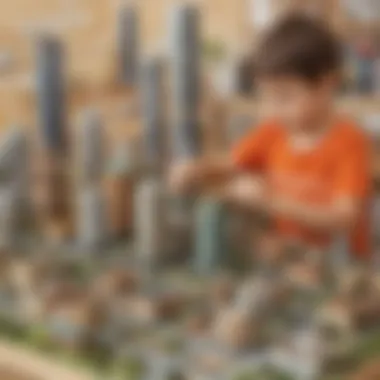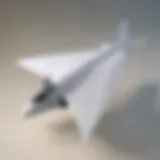Inspiring STEM Activities for Kids: A Comprehensive Guide


Fun Activities Ideas
STEM activities for kids are a fantastic way to nurture young minds and foster a love for learning in a fun and engaging manner. Whether it's experimenting indoors, embarking on outdoor adventures, exploring arts and crafts, conducting science experiments, or getting hands-on with cooking and baking, these activities offer children a hands-on approach to understanding STEM concepts. By participating in these activities, kids can enhance their creativity, problem-solving skills, and critical thinking abilities through interactive learning experiences.
Indoor Activities
Indoor STEM activities provide children with the opportunity to learn and explore scientific principles within the comfort of their homes. From building simple machines to creating art using recycled materials, indoor activities can spark curiosity and innovation in young minds. These activities not only promote scientific discovery but also encourage children to think analytically and creatively.
Outdoor Adventures
Outdoor STEM activities enable kids to connect with nature while engaging in hands-on learning experiences. From identifying local flora and fauna to experimenting with wind power, outdoor adventures offer children a chance to apply STEM concepts in real-world situations. Through outdoor exploration, kids can develop a deeper appreciation for the natural world and cultivate a sense of scientific inquiry.
Arts and Crafts
STEM-themed arts and crafts activities combine creativity with scientific exploration, allowing kids to express themselves artistically while learning fundamental STEM concepts. From designing paper circuit cards to constructing straw rockets, arts and crafts projects offer children a unique opportunity to engage with both visual and tactile learning experiences. These activities foster innovation and imagination in young learners, encouraging them to think outside the box.
Science Experiments
Conducting science experiments at home not only promotes scientific literacy but also instills a sense of wonder and curiosity in children. Whether it's observing chemical reactions, studying the properties of light, or exploring the world of magnets, hands-on science experiments allow kids to apply the scientific method in a controlled setting. By encouraging kids to ask questions, make predictions, and analyze results, these experiments cultivate essential scientific skills and knowledge.
Cooking and Baking
Integrating STEM principles into cooking and baking activities offers children a delicious way to learn about math, chemistry, and physics. From measuring ingredients to understanding how heat affects food, cooking and baking projects provide kids with a hands-on understanding of scientific concepts in the kitchen. By experimenting with recipes and exploring culinary techniques, children can develop a passion for STEM while honing their culinary skills.
Introduction to STEM Activities
STEM education is a vital aspect of children's development, fostering skills crucial in today's world. This article delves into a plethora of engaging STEM activities tailor-made for kids. By providing hands-on experiences and interactive learning, these activities aim to ignite a spark of curiosity and innovation in young minds. From simple experiments to complex projects, the journey through STEM opens doors to creativity and critical thinking.
Understanding STEM Education
The Importance of STEM Learning
In the realm of education, STEM learning stands out for its emphasis on integrated learning across science, technology, engineering, and mathematics. This holistic approach equips children with multifaceted skills, preparing them for future challenges. The dynamic nature of STEM learning cultivates a problem-solving mindset, promoting adaptability and analytical thinking. Amidst technological advancements, embracing STEM education becomes imperative to nurture a generation capable of shaping tomorrow's world.
Benefits of Integrating STEM Activities
Integrating STEM activities into educational settings offers a myriad of benefits. It not only enhances academic performance but also instills practical skills essential for real-world applications. By engaging in hands-on projects, children develop teamwork, communication, and critical thinking skills. The interdisciplinary nature of STEM activities exposes students to diverse fields, broadening their perspective and encouraging innovation.
Impact of Hands-on Learning
Hands-on learning experiences play a pivotal role in reinforcing conceptual understanding. Through hands-on activities, children actively engage with abstract concepts, facilitating better retention and comprehension. The tactile nature of hands-on learning sparks children's curiosity and creativity, making learning a dynamic and immersive process. This experiential approach not only enhances academic achievement but also fosters a lifelong love for learning.
Science-Based Activities
STEM education revolves around Science-Based Activities, playing a crucial role in fostering children's cognitive development. These activities not only enhance problem-solving skills but also promote a deeper understanding of scientific concepts from an early age. By engaging in hands-on experiments and simulations, kids can explore various scientific phenomena, stimulating their curiosity and analytical thinking. Science-Based Activities lay the foundation for critical skills essential in today's technology-driven world.
Simple Science Experiments
Invisible Ink Experiment


The Invisible Ink Experiment offers children a fun and intriguing way to learn about chemical reactions and hidden messages. This activity encourages creativity and ingenuity while introducing scientific principles in a captivating manner. Participants can use common household items like lemon juice or baking soda to uncover invisible messages, fostering a sense of discovery and experimentation. While this experiment is simple to set up and execute, it provides a valuable lesson in the properties of substances and the reactions they undergo.
Volcano Eruption Simulation
The Volcano Eruption Simulation is a popular Science-Based activity that sparks interest in geology and earth sciences. By creating a miniature volcano model and triggering a chemical reaction to simulate an eruption, children can witness firsthand how volcanic activity occurs. This experiment blends art and science, enabling kids to grasp concepts like pressure and eruption mechanisms through a hands-on approach. The visual and interactive nature of this simulation makes it a compelling choice for engaging young minds in scientific exploration.
Rainbow Walking Water
Rainbow Walking Water is a visually stunning experiment that introduces children to capillary action and color mixing. By using water, paper towels, and food coloring, participants can observe how liquid travels through absorbent materials, creating a beautiful rainbow effect. This activity not only demonstrates scientific principles related to liquid movement but also encourages artistic expression through color blending. Rainbow Walking Water showcases the integration of art and science, making it an enriching and engaging option for young learners.
Engineering Challenges
Engineering Challenges offer kids the opportunity to apply critical thinking and creativity in designing and constructing various structures. These activities cultivate problem-solving skills and spatial awareness, fostering an appreciation for engineering principles. By engaging with challenges like building bridges, marble runs, and paper airplanes, children can enhance their dexterity and strategic planning while exploring the practical applications of physics and design concepts.
Build a Bridge
Building a Bridge activity prompts children to design and construct a sturdy bridge using everyday materials like toothpicks or popsicle sticks. This challenge encourages participants to consider the principles of balance, weight distribution, and structural stability. By testing different designs and materials, kids can enhance their understanding of engineering concepts such as load-bearing capacity and architectural integrity.
Create a Marble Run
Creating a Marble Run allows children to explore concepts of momentum, gravity, and kinetic energy through hands-on construction. Participants design intricate tracks and pathways to guide marbles through a maze of obstacles and twists. This challenge promotes spatial reasoning and problem-solving skills, as kids work to optimize their designs for smooth marble motion. The interactive nature of Marble Run projects makes them a dynamic and engaging choice for incorporating engineering principles into play.
Paper Airplane Design
Paper Airplane Design combines aerodynamics and creativity, enabling children to experiment with different folding techniques and designs to achieve optimal flight performance. This activity emphasizes the principles of lift, drag, and thrust in a playful and interactive way. Through trial and error, kids can refine their paper airplane models, learning about aerodynamic forces and the impact of design modifications on flight characteristics. Paper Airplane Design offers an engaging avenue for exploring basic aviation principles and igniting a passion for aeronautical engineering.
Nature Exploration
Nature Exploration activities immerse children in the wonders of the natural world, fostering an appreciation for biodiversity and environmental conservation. By engaging in projects like bird feeder construction, butterfly garden planning, and seed germination experiments, kids can connect with nature while acquiring valuable knowledge about ecosystems, plant life cycles, and sustainable practices.
Bird Feeder Construction
Bird Feeder Construction empowers children to create welcoming spaces for wildlife, encouraging bird watching and habitat preservation. By using recycled materials or household items, participants can design bird feeders that attract local avian species, promoting biodiversity in their surroundings. This activity not only nurtures a sense of environmental stewardship but also provides kids with a hands-on experience in crafting functional and eco-friendly objects.
Butterfly Garden Planning
Butterfly Garden Planning invites children to design butterfly-friendly habitats that support pollination and conservation efforts. By selecting nectar-rich plants and creating suitable conditions for butterfly species, kids can observe the life cycle of these colorful insects up close. This project instills an understanding of ecological interdependencies and the importance of preserving natural habitats for pollinators. Butterfly Garden Planning blends creativity with environmental awareness, offering a holistic learning experience that underscores the significance of biodiversity conservation.
Seed Germination Project
The Seed Germination Project introduces children to the process of plant growth and germination, fostering an interest in botany and gardening. By planting seeds and observing their development over time, participants learn about the essential factors for successful germination, such as water, light, and soil nutrients. This project not only cultivates a sense of responsibility in caring for living plants but also educates kids on the life cycle of flowering plants and the significance of sustainable agriculture. The Seed Germination Project provides a hands-on exploration of biology and ecology, promoting a deeper connection to the natural world and the principles of life science.
Technology Activities
In the realm of STEM activities for kids, Technology Activities play a crucial role in fostering innovation and problem-solving skills. By engaging children in coding projects, robotics, and AI explorations, these activities promote digital literacy and computational thinking crucial for the future workforce. Introducing children to technology at a young age can inspire a passion for STEM fields and prepare them for the increasingly digital world ahead. Parents, teachers, and caregivers can leverage Technology Activities to not only enhance children's technical skills but also cultivate creativity and logical reasoning.
Coding Projects
Create a Simple Animation


Creating a Simple Animation is a gateway for children to explore the world of animation and digital storytelling. This activity allows kids to visualize their ideas, learn programming fundamentals, and express creativity through motion and design. The simplicity of creating animations gives children a hands-on experience in coding while sparking their imagination. This project not only enhances their technical skills but also encourages them to think critically and logically in problem-solving situations. While the process of creating animations can be challenging, it fosters resilience and perseverance in young minds, essential qualities for future success.
Code a Virtual Pet
Coding a Virtual Pet introduces children to the concept of interactive programming in a fun and engaging way. By designing and coding a digital pet, kids learn about variables, loops, and decision-making, all fundamental aspects of programming. This activity not only hones children's coding skills but also encourages them to think algorithmically and creatively. The virtual pet project allows kids to personalize their creation, leading to a sense of ownership and accomplishment. While coding a virtual pet may have its complexities, it provides a hands-on opportunity for children to learn and experiment with coding concepts in a playful environment.
Design a Digital Storybook
Designing a Digital Storybook merges technology with storytelling, providing children with a platform to create immersive narratives using digital tools. This activity blends art and technology, allowing kids to express their creativity through digital media. By designing characters, settings, and plotlines, children engage in multimedia storytelling, enhancing both their technical abilities and narrative skills. Designing a digital storybook not only sparks imagination but also improves children's digital literacy and communication skills. While the process of digital storytelling may require attention to detail and patience, it inspires children to communicate effectively through innovative mediums.
Robotics and AI Exploration
Build a Brush Bot
Building a Brush Bot introduces children to basic robotics concepts in a hands-on and interactive manner. This activity involves creating a simple robot using everyday materials like a toothbrush, a motor, and a battery. Building a Brush Bot not only familiarizes kids with engineering principles but also instills problem-solving skills as they troubleshoot and adjust their robots. The process of constructing a Brush Bot encourages children to experiment, innovate, and learn through trial and error, fostering a growth mindset and resilience. While building a Brush Bot may require attention to detail and precision, it cultivates a sense of curiosity and exploration in young learners.
Design a Robotic Hand
Designing a Robotic Hand allows children to delve into the world of mechanical engineering and robotics by building a functional robotic hand. This project challenges kids to understand anatomy, mechanics, and engineering design as they create a hand that can grasp and manipulate objects. Designing a Robotic Hand not only enhances children's engineering skills but also encourages them to think creatively and analytically when solving real-world problems. The project provides a hands-on experience in robotics, fostering collaboration, communication, and innovation. While designing a robotic hand may involve complex mechanisms and construction, it empowers children to explore the intersection of technology and human anatomy.
Explore Machine Learning Concepts
Exploring Machine Learning Concepts introduces children to the fascinating world of artificial intelligence and machine learning. This activity allows kids to experiment with algorithms, data analysis, and pattern recognition, foundational aspects of AI technology. By engaging in machine learning projects, children develop critical thinking skills, logical reasoning, and an understanding of how computers learn and make decisions. Exploring Machine Learning Concepts not only expands children's technological proficiency but also encourages them to ask questions, investigate patterns, and draw conclusions from data. While delving into machine learning may involve conceptual complexities, it empowers children to explore the capabilities and limitations of AI technology in a hands-on and interactive manner.
Engineering Activities
Engineering activities play a pivotal role in this article, emphasizing practical applications of scientific principles. By engaging in hands-on engineering challenges, children can enhance their problem-solving skills and creativity. These activities provide a platform for kids to explore structural design, renewable energy, and more within the STEM education framework.
Structural Design Challenges
Create a Straw Tower
Create a Straw Tower activity introduces kids to the fundamental concepts of structural stability and balance. This challenge encourages youngsters to utilize simple materials like straws to construct a tower that can withstand external forces. The key characteristic of this activity lies in its ability to enhance spatial awareness and engineering ingenuity. While the activity is popular for its simplicity, it also fosters critical thinking and perseverance in young learners. Children can experiment with different designs to understand the impact of structure on stability and load-bearing capacity.
Build a Popsicle Stick Bridge
Building a Popsicle Stick Bridge challenge introduces kids to basic engineering principles related to bridges. This activity focuses on constructing a bridge using popsicle sticks while considering factors like span, load distribution, and support mechanisms. The key characteristic of this project is its blend of creativity and structural integrity. Kids learn to design bridges that can support weight effectively, promoting critical thinking and innovative problem-solving. While popular for its hands-on nature, this activity also encourages children to experiment with various bridge designs to improve functionality and durability.
Construct a Marshmallow Catapult
Constructing a Marshmallow Catapult challenge allows children to explore principles of mechanics and projectile motion. This activity involves building a device capable of launching marshmallows at different distances. The key feature of this project is its combination of engineering principles and interactive fun. Kids engage in designing catapults that optimize launch distance and accuracy, honing their understanding of force and trajectory. Despite being a popular choice for its entertainment value, this activity also cultivates a scientific mindset by encouraging experimentation and refinement of design.
Renewable Energy Projects
Build a Solar Oven
Building a Solar Oven project introduces children to the concept of harnessing solar energy for practical use. This activity focuses on constructing an oven that can cook food using solar heat. The key characteristic of this undertaking is its emphasis on sustainable energy practices and innovation. Kids learn the importance of renewable resources while exploring the principles of solar thermal energy conversion. By building and testing solar ovens, children grasp the potential of eco-friendly technology and its impact on daily life. Although known for its hands-on appeal, this project also instills a sense of environmental consciousness and scientific curiosity in young participants.
Design a Wind Turbine


Designing a Wind Turbine activity immerses kids in the world of wind energy and power generation. This project involves creating a miniature turbine that converts wind energy into motion. The noteworthy aspect of this endeavor is its focus on alternative energy sources and technological innovation. Children delve into aerodynamics and energy conversion mechanisms while designing efficient turbines. Through experimentation and optimization, kids grasp the significance of wind power in sustainable energy solutions. Apart from being engaging, this activity encourages critical thinking and exploration of renewable energy concepts.
Explore Hydroelectric Power
Exploring Hydroelectric Power project introduces children to the concept of generating electricity from water resources. This activity involves building models to demonstrate hydroelectric power generation principles. The prominent feature of this engagement is its hands-on approach to understanding clean energy production. Kids explore water flow dynamics and turbine functionality while creating working models of hydroelectric systems. By investigating renewable energy generation firsthand, children appreciate the potential of hydroelectric power in addressing energy needs sustainably. Despite its entertaining nature, this project instills a sense of innovation and environmental stewardship in young learners.
Mathematics Activities
Mathematics activities play a crucial role in this comprehensive guide to engaging STEM activities for kids, offering a unique avenue for children to develop their problem-solving skills, logical reasoning, and critical thinking abilities. By incorporating math games and puzzles into the learning mix, children can enhance their numerical fluency and spatial awareness while nurturing a positive attitude towards mathematical concepts. These activities also promote creativity and persistence, essential qualities for success in STEM fields. Parents, teachers, and caretakers can leverage math activities to inspire a love for numbers and problem-solving in children from a young age, laying a solid foundation for their academic and professional pursuits.
Math Games and Puzzles
Sudoku Challenges
Sudoku challenges in this article provide an exciting and effective way to improve children's concentration, memory retention, and cognitive skills. By tackling Sudoku puzzles, kids strengthen their logical thinking, pattern recognition, and problem-solving capabilities. The structured format of Sudoku promotes systematic thinking and disciplined approach towards finding solutions, fostering resilience and strategic planning. Sudoku challenges are highly beneficial for enhancing children's numeracy skills and cultivating a methodical thinking process, making them a popular choice for integrating into STEM-oriented activities.
Geometry Art Projects
Geometry art projects offer a blend of creativity and mathematical principles, encouraging children to explore shapes, angles, and spatial relationships through artistic expression. By engaging in hands-on geometry projects, kids can visualize abstract concepts, develop visual-spatial intelligence, and enhance their geometric reasoning. The combination of art and math stimulates critical thinking and creativity, enabling children to see math as a tangible and relatable subject. Geometry art projects are a valuable addition to this article, providing a multi-dimensional approach to learning and showcasing math in an engaging and visually appealing manner.
Mathematical Treasure Hunts
Mathematical treasure hunts inject an element of adventure and intrigue into the learning process, transforming math challenges into exciting quests. These activities enhance children's problem-solving skills, number manipulation, and analytical thinking as they search for hidden clues and solve mathematical riddles. Mathematical treasure hunts promote collaboration, communication, and critical reasoning among participants, making math discovery a thrilling and interactive experience. With an emphasis on exploration and discovery, these treasure hunts bring math to life, making it a dynamic and engaging component of the STEM activities highlighted in this article.
Real-World Problem Solving
Budget Planning Simulations
Budget planning simulations provide a practical and immersive way for children to learn financial literacy, decision-making, and resource management. By simulating real-life budget scenarios, kids can develop budgeting skills, prioritize expenses, and understand the value of money. Budget planning simulations offer a hands-on approach to financial education, teaching children the importance of planning, saving, and making informed financial choices. These simulations also foster a sense of accountability and responsibility, empowering children to make sound financial decisions from a young age.
Data Analysis Experiments
Data analysis experiments introduce children to the world of data interpretation, statistical analysis, and problem-solving using information-driven insights. By engaging in data experiments, kids learn to collect, organize, and analyze data to draw meaningful conclusions and make informed decisions. Data analysis activities enhance critical thinking, logical reasoning, and quantitative skills, preparing children to navigate the data-rich landscape of the digital age. With a focus on empirical evidence and logical deductions, data analysis experiments empower children to think analytically and approach problems methodically, contributing to their overall cognitive development.
Measurement Exploration
Measurement exploration activities open a gateway to understanding the fundamental principles of size, quantity, and comparison, allowing children to explore the world through a quantitative lens. By immersing in measurement tasks, kids develop estimation skills, precision in measurement, and grasp of units and conversions. Measurement exploration fosters spatial awareness, mathematical reasoning, and scientific inquiry, enabling children to make sense of the physical environment and apply mathematical concepts to real-world scenarios. Through hands-on measurement exercises and experiments, children gain a deeper appreciation for the role of measurement in science, engineering, and everyday life, enhancing their mathematical fluency and analytical thinking skills.
Conclusion
In this final section of the article, we delve into the crucial aspect of encouraging curiosity and innovation in children through STEM activities. The significance of fostering curiosity and innovation lies in nurturing a love for learning, building resilience in facing challenges and failures, and celebrating creativity in problem-solving. By promoting these key elements, children are equipped with essential skills for future success.
Encourage Curiosity and Innovation
Fostering a Love for Learning
Fostering a love for learning is a foundational element in the world of STEM activities. It plays a pivotal role in cultivating a deep sense of curiosity and enthusiasm for exploration in children. By instilling a passion for learning early on, children are more likely to engage actively and persistently in educational pursuits. The key characteristic of fostering a love for learning is its ability to inspire a lifelong dedication to acquiring knowledge and skills. This deep-rooted interest acts as a driving force behind continuous learning and personal growth. Fostering a love for learning not only enhances academic performance but also fosters a sense of curiosity that transcends traditional educational boundaries. Its unique feature lies in its potential to ignite a spark of curiosity that fuels a child's thirst for knowledge. While the advantages of fostering a love for learning are vast, including improved cognitive abilities and enhanced problem-solving skills, there may be challenges in maintaining sustained interest over time.
Embracing Challenges and Failures
Embracing challenges and failures is a fundamental aspect of the learning process within STEM activities. By encouraging children to embrace challenges and learn from failures, they develop resilience and perseverance in the face of obstacles. The key characteristic of this approach is its emphasis on growth mindset and belief in the value of learning from setbacks. Embracing challenges and failures is a popular choice for this article as it instills a sense of resilience and adaptive thinking in children. The unique feature of this approach is its transformative impact on a child's attitude towards obstacles, turning them from barriers into opportunities for growth. While the advantages of embracing challenges and failures include resilience, determination, and self-improvement, there may be disadvantages in dealing with initial frustrations and setbacks.
Celebrating Creativity in Problem-Solving
Celebrating creativity in problem-solving is another essential component of fostering innovation in children through STEM activities. By encouraging creative thinking and innovation, children learn to approach problems from different perspectives and explore diverse solutions. The key characteristic of celebrating creativity in problem-solving is its emphasis on originality and out-of-the-box thinking. This approach is a beneficial choice for this article as it nurtures a child's creative potential and encourages experimentation. The unique feature of celebrating creativity in problem-solving is its ability to unleash unconventional ideas and novel solutions to complex problems. While the advantages include fostering a creative mindset and promoting innovation, there may be challenges in assessing the effectiveness of unorthodox approaches.



